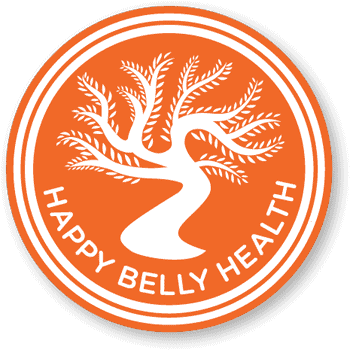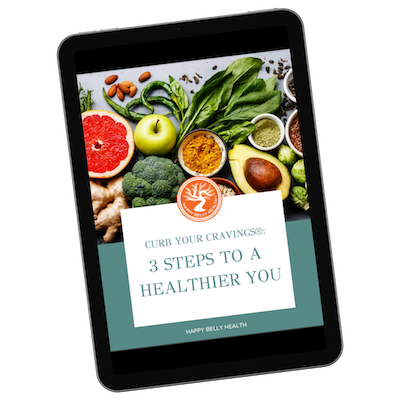Stomach Acid is Good For You – But is Often Impaired!
Normally, a healthy stomach creates a helpful and necessary, strongly acidic environment with a pH of between 1.0 and 2.5. However, there are many modern lifestyle dynamics that can lead to lowered production of stomach acid. In particular, sustained stress or suboptimal thyroid function are both quite common and can lead to a reduction in stomach acid secretion. There are also autoimmune dynamics which can directly impair acid production.
As we grow older, however, the primary dynamic that decreases stomach acid production is a gastric infection of a bacteria called Helicobacter Pylori (or H. Pylori, for short). These bacteria are endemic to the human gut, but they can overgrow in a “simmering” infection in the background and affect us for decades. With the right perfect storm of factors, this infection can become acute and cause an ulcer. A simmering H pylori infection is often responsible for a progressive reduction in stomach acid as we age. H pylori overgrowth is more common when we have lower stomach acid, and once well established, the bacteria further suppress stomach acid in order to make their home more hospitable. It is estimated that a full 50% of people aged 60 or older produce insufficient stomach acid. By age 85, this percentage increases to 80%! Regardless of the root causes, we call this dis-ease state hypochlorhydria – and it can far-reaching impact that is seldom acknowledged in conventional medicine.
To make matters worse, our modern society frequently uses acid-suppressing medications which reduce gastric juice acidity on purpose – dramatically – to bring relief from acid reflux (GERD). These drugs most often include the powerful proton pump inhibitors or PPIs (e.g. Nexium®, Prilosec®) and the less aggressive H2 receptor blockers (e.g. Zantac®, Pepcid®). Typical “painkiller” NSAID medications (e.g. aspirin, ibuprofen such as Advil®, Motrin®) can also impair stomach acid production and damage the lining of the stomach. Antibiotic use may also reduce stomach acid. All of these medications may bring important, triage relief for various medical conditions. Ongoing use, however, may have dramatic downstream consequences, especially for PPIs.
If you have an ulcer or gastritis, stomach acid inhibition can be particularly beneficial in the short-term, but long-term, we lose the ability to absorb optimal nutrition from our food. After all, it’s not so much that “we are what we eat”; actually, we are what we Eat, Digest, and Absorb!
We need strong stomach acid for optimal digestion. In the stomach, we denature proteins to ensure optimal absorption of amino acids in the intestines, prepare Vitamin B12 so it can be absorbed at all, and separate tightly-bound minerals to allow for intestinal uptake (e.g. iron, magnesium, chromium, zinc). When stomach pH becomes less acidic (that is, more alkaline) it also inhibits the action of pepsin, a critical protein-digesting enzyme in the stomach. Plus, strong stomach acid helps to ensure an overall optimal pH in our intestines which
- ensures optimal release of both pancreatic and gallbladder digestive fluids and (2) allows digestive enzymes to work at their peak effectiveness.
Hypochlorhydria has been associated with many common health problems. Adequate HCI is necessary for denaturing proteins to allow optimal amino acid availability such as is needed for hormone and neurotransmitter synthesis. B12 deficiency may cause cognitive impairment, fatigue/weakness, impaired methylation/detoxification, neuropathy, and other nervous system problems. Insufficient mineral absorption can lead to a myriad disease states in the body from anemia to type 2 diabetes, autoimmune diseases, arthritis, depression, hypothyroidism, and more.
There are many common symptoms of hypochlorhydria, and a given individual may only suffer from a few of these (and the effects might be intermittent):
- Feeling nauseated after taking supplements (except zinc which may promote nausea on its own)
- Clearly seeing undigested food in stools
- Upper GI bloating, belching, and/or an early sense of satiety during or right after meals
- Irritable bowel syndrome (IBS) or frequent gut infection or microbial imbalance (e.g. candida, parasite)
- Feeling particularly fatigued after meals (especially if meal was otherwise consumed slowly)
- Insufficient levels of Vitamin B12 and/or iron despite eating a carnivorous diet
- Hair or nails that break frequently or are thin
- Chronic allergy or urticaria
- Multiple mineral deficiencies despite a whole foods diet (e.g. zinc, magnesium, chromium, copper)
- Rosacea
- Osteoporosis or advanced osteopenia
- Multiple food allergies or sensitivities
- Asthma, especially if wheezing is also involved
- Chronic indigestion or GERD
Low Stomach Acid Experiment
The goal is to give the body an opportunity to experiment with increased stomach acidity and communicate by its reaction whether the support is needed and, if so, how much is optimal at this time. Stomach acidity supplementation can be a very beneficial choice while you are working with your healthcare practitioner to address the upstream root causes of the deficiency.
Plan your experiment over a week when you will be living your typical lifestyle and have time to focus
self-awareness on your body. Acquire capsules of “HCl betaine with pepsin” (HCl); most brands will contain 600-650mg per capsule.
If you don’t need any additional stomach acid support at all, using just one capsule of HCl would cause a slight discomfort or warm sensation in the center of the chest. If you feel fine with one capsule, you may or may not need a higher dosage, so we begin to experiment slowly and steadily with increased intake to find the level at which your body indicates an excessive amount. Then your optimal dose is likely one less capsule. We explore each new dose across multiple meals to allow learning about how meal circumstances and meal make-up change the dosage your body needs.
Protein-containing meals require more HCl support, and large animal protein portions usually require the most. You can develop an intuition about how to vary your intake.
Here are specific instructions for carrying out your own Low Stomach Acid Experiment. Don’t hesitate to ask your healthcare practitioner any questions you may have.
- Start by taking one capsule of HCl in the middle of your typically largest meal of the day and during a meal that contain protein. Note the timing is key: don’t take the capsule at the beginning of or after the meal.
- If you do not feel a burning sensation or anything undesired, begin taking one capsule with every protein-containing meal for the next 2 full days (6 meals). You may indeed notice positive effects at this or higher doses e.g. less sense of fullness, higher post-meal energy, better bowel movements, reduction of acid reflux or indigestion. At this point, don’t use HCl with a snack or a tiny meal (e.g. a few slices of turkey).
- If you notice no negative reactions after 6 meals with one capsule, increase the number of capsules with each meal to two. Again, continue to take them in the middle of the meal with a few bites of food in between.
- Continue increasing the number of capsules every 2-3 days, using up to eight capsules with each meal if necessary. These dosages may seem large, but a normally functioning stomach manufactures considerably more.
- As a reminder, you will know if you have taken too many capsules with that particular meal if you experience any of the following: warmth, tingling, or burning in the chest, diarrhea, neck or back achiness, heartburn, or any unusual symptom that makes you uncomfortable or uneasy. With this slow, progressive experiment, you are unlikely to experience anything alarming, but if you feel uncomfortable, you may quickly neutralize the higher acidity quickly by drinking ½ teaspoon of baking soda stirred into ½ cup of water.
- Remember: the goal is to find that excessive level. When you do, stop using HCl for the remainder of that day and then resume the next day using a dose that is one capsule less than the dose that gave you discomfort. If you have noticed no symptoms up to 8 capsules, stay at that dose for now.
- Again, most people will find that different meal circumstances and composition will dictate a variable dose that you can learn to master over time. Some people find they require 6-8 capsules with every meal while others find they only need 1-2 and only with sizeable protein- containing meals. Stomach acid is important, so be consistent in your use of HCl.
- As you work with your healthcare practitioner to address the root causes of your unique case of hypochlorhydria, your own innate stomach acid secretion will likely improve or return. You will then notice that your body does not tolerate the previously typical HCl dose and will give you symptoms, indicating a need to cut back on the dose. Try to be patient as your body heals. Some individuals do need to supplement with HCl long-term to support optimal wellness.
Cautions and Considerations
Individuals who have had insufficient stomach acid for some time often have had a thinning of the protective mucosal lining of the stomach. Talk to your healthcare practitioner about your unique circumstances. You may need to support the repair and build-up of this protective barrier before increasing stomach acidity. This is especially true of individuals who have been using acid-suppressing medication (and especially PPIs). If you have several signs/symptoms of hypochlorhydria and yet find that just one capsule of HCl causes a burning sensation, you likely need to support your mucosal lining for 2-3 weeks and then resume your HCl experiment.
Do not use HCl if you are taking certain medications that may weaken or damage the mucosal lining of the stomach, including steroids (e.g. prednisone) and NSAIDs (e.g. ibuprofen, aspirin, diclofenac). There is an increased risk of gastritis or GI bleeding.
Use of HCl is contraindicated in individuals with gastritis or ulcers as it can inflame tissue that is not being adequately protected.
Do not open HCl capsules or try to mix the contents into any other foods or beverages. Take the capsules intact. Only use HCl in the middle of meals, not at the beginning or the end of meals.
Be sure to take a bite or two of food soon after each capsule is swallowed to ensure it is well pushed down into the stomach. A capsule that gets stuck to the esophagus can be uncomfortable.
Rare individuals will not be able to tolerate HCl at all due to a sensitivity to one of the ingredients. In these cases, a Tbsp or two of apple cider vinegar or lemon juice mixed with a ½ cup of water may be sipped on throughout a meal to help increase stomach acidity. This approach is less targeted and intense than HCl but appropriate for these sensitive individuals.
If you would like some customized support to delve deeper into your health and nutrition, let’s chat.
© Purpose Inc., The School of Applied Functional MedicineTM





